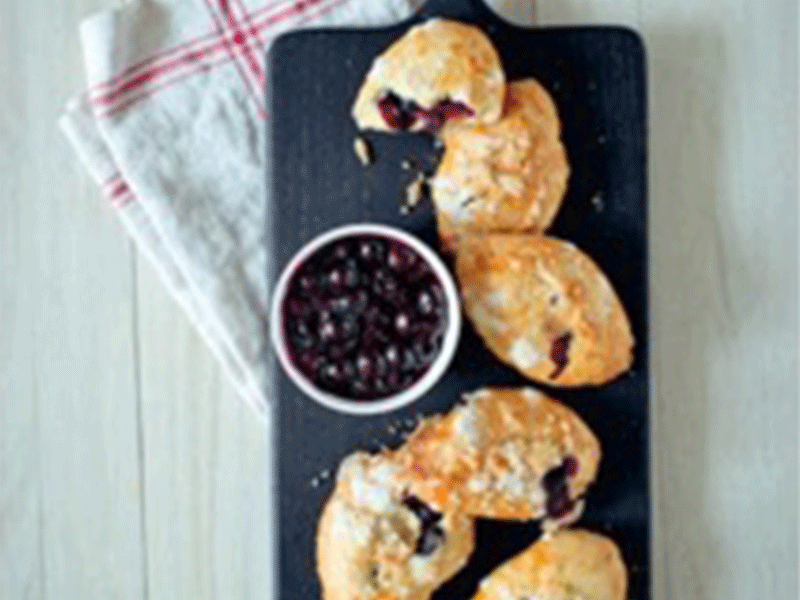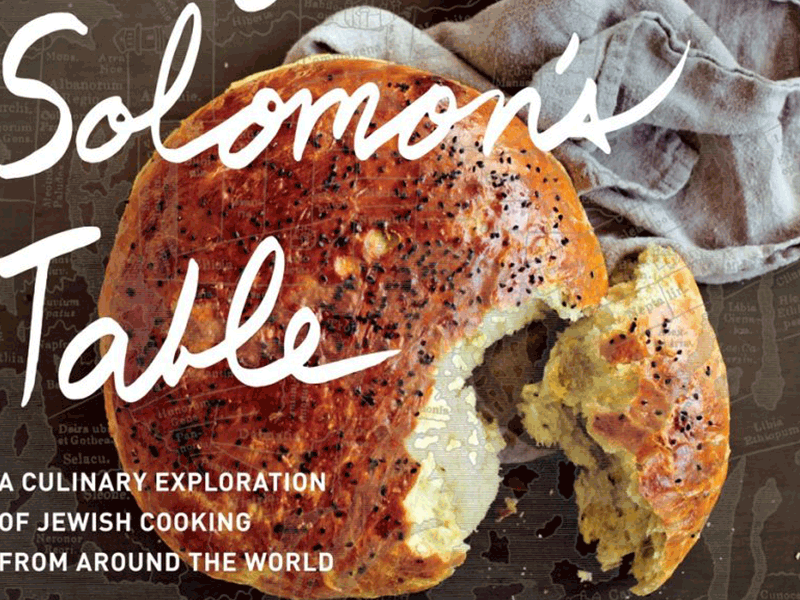Good Shabbos, Shabbat Shalom! For 40 years, award-winning cookbook author, Joan Nathan, “the queen of American Jewish cooking,” has made it her mission to uncover the forgotten recipes of the Jewish diaspora. In her latest cookbook, King Solomon’s Table: A Culinary Exploration of Jewish Cooking from Around the World (Knopf), Nathan draws on her decades of travels – from Israel to Italy to India and beyond – to give us an incredible collection of Jewish recipes from around the globe and across the ages.
The biblical King Solomon, driven by a passion for discovery, is said to have sent emissaries on land and sea to all corners of the ancient world, initiating a mass cross-pollination of culinary cultures that continues to bear fruit today. Nathan has gathered together more than 170 recipes that reflect the incredible breadth and depth of Jewish cooking.
One of the fascinating features of King Solomon’s Table is that each recipe includes an enticing story filled with historical and personal tidbits, plus there are gorgeous colour photos throughout the book. Her recipe for “New Old-Fashioned Bagels” is similar to Montreal-style bagels – thinner and smaller, but with salt and less sweetness. She writes at length about the history of the bagel, a roll-with-a-hole, in “The Bagel’s Journey from Ancient Egypt to Almost Everywhere.” Canadian readers, particularly those who grew up in Toronto, will be thrilled to discover the recipe for the famous Shtritzlach, Toronto Blueberry Buns (below).
In King Solomon’s Table, you’ll find a wonderfully diverse collection of recipes, including T’Beet (Baghdadi Sabbath overnight spiced chicken with rice and coconut chutney), Kishka, Jerusalem kugel, and salmon gefilte fish mold with horseradish and beet sauce. For those of you celebrating the upcoming American Thanksgiving holiday, Nathan’s recipe for roast turkey with challah-chestnut-cranberry stuffing is a terrific choice. For Chanukah, there are several selections, including green chile relleno latkes, zucchini fritters, and soufganiyot. Other amazing sweets include apple kuchen, putterkuchen (butter crumble cake), and Libyan saefra, also known as King Solomon’s cake. Her recipe for Schokoladenwurst, chocolate sausage, is below or you can watch the video here: https://www.youtube.com/watch?v=XC7PC78WLYs
Nathan’s website is http://joannathan.com.
King Solomon is said to have ruled for 40 years, amassing enormous wealth. With a ravenous appetite for all aspects of life, he had seven hundred wives (among them a daughter of the pharaoh) and more than three hundred mistresses! Some of his wives came from Egypt, Moab, Ammon, Edom (present-day Jordan), Sidon (present-day Lebanon), and Anatolia (present-day Turkey) – the lands near and surrounding Judea in ancient Israel. They would likely have brought pomegranates, dates, olives, and a variety of other foods and methods for preparing them.
Nathan writes: “How amazing it is – sometimes it even takes my breath away – when gathered around the Passover table, we think that Jews are sitting around similar tables across the world, eating symbolic foods absorbed from culinary traditions developed over thousands of years.”
Nathan is “the” authority on Jewish cooking and her fascinating cookbook, King Solomon’s Table, will make an excellent addition to your cookbook library. Highly recommended!
 SHTRITZLACH, TORONTO BLUEBERRY BUNS
SHTRITZLACH, TORONTO BLUEBERRY BUNS
Adapted from King Solomon’s Table by Joan Nathan (Knopf 2017)
Joan Nathan shares: “Nearly every person I meet from Toronto describes shtritzlach, called blueberry buns in this Canadian city… I discovered that this is one of those recipes that would have been lost but for a few survivors and those that left Poland before the Holocaust.”
She explains: “Although shtritzlach means “currant cakes” in Yiddish, blueberries replace the currants or raisins in summer, and that’s when the English name stuck. The late Annie Kaplansky ate them in her youth in Rakow, in southwest Poland. When she immigrated to Toronto in the late 1920s and opened the Health Bread Bakery, she started making these blueberry pockets, which were a huge hit.”
She continues: “By the time the bakery was sold with the recipe in the 1950s, the buns had become an iconic Toronto Jewish favourite. The new owner, at the renamed Open Window Bakery, used blueberry pie filling, a new popular convenience item. (This could explain why some remember the buns fondly, while others think of them in less pleasant terms.)”
Nathan writes: “According to Goldie Szachter Kalib’s memoir, the buns, originally served as a breakfast food, especially on the Sabbath, were made with sweet yeast dough brimming with berries. They were clearly an object of nostalgia for Jews who lived in prewar Poland and later came to Toronto. The recipe, like many others, might have been lost because most of the Jewish inhabitants of these small towns in southwest Poland perished in the camps. Thanks to the late Annie Kaplansky for rescuing this authentic and delicious pastry that bakes up into golden treats perfect for breakfast or a snack.”
2 3/4 cups all-purpose unbleached flour, divided, plus flour for kneading
1/2 tsp salt
1 cup sugar, divided, plus 1 Tbsp sugar
8 Tbsp/1 stick unsalted butter at room temperature, divided
1 Tbsp yeast
2 large eggs plus 1 egg yolk
2 heaping Tbsp sour cream
1 1/2 cups blueberries (about)
2 Tbsp chopped candied ginger (optional)
- Mix 2 1/2 cups of the flour, salt, and 3/4 cup of the sugar in a mixing bowl, add half the butter, mix well, and as Sarah’s grandmother did, make a well in the center. Mix the yeast with 1/4 cup of warm water and stir in. Add the 2 whole eggs and the sour cream, mixing well with a spoon. (You can also put everything in a standing mixer.) Then cover with plastic wrap and let sit for about 2 hours until the dough doubles in volume.
- Using your fingers, blend the remaining 1/4 cup of flour and 1/4 cup of sugar with the remaining butter and set aside in a bowl.
- Preheat the oven to 350 degrees F and cover two baking sheets with parchment paper.
- Dust a baking board with flour and roll out the dough to a circle about 1/8 inch thick, adding more flour if the dough sticks. Cut into 12 three-inch rounds and press at least 12 blueberries into each round of dough and sprinkle with a little of the remaining tablespoon of sugar and the candied ginger, if using. Then, cradling the filled circle of dough in one hand, use your second hand to carefully pinch it closed into a 3-by-5-inch oblong shape. Repeat with the remaining dough and blueberries. Put the buns on the baking sheets.
- Brush the buns with the remaining egg yolk, pat the streusel – the flour-sugar-butter mixture (see Step 2, above) – on top of the buns, and bake for about 25 minutes or until golden—don’t worry if some of the juices boil over. That is part of the buns’ charm. Serve warm or at room temperature.
Yield: 12 blueberry buns
SCHOKOLADENWURST, CHOCOLATE SAUSAGE
Adapted from King Solomon’s Table by Joan Nathan (Knopf 2017)
Joan Nathan recalls: “In isolated Jewish communities like that of El Salvador, a kind of culinary lag exists with regard to holiday foods. There we can often find delicious recipes not found elsewhere anymore. When I visited El Salvador, Daniel Guttfreund, a local psychologist, organized a Sabbath dinner with Jewish dishes that his family has eaten every Friday night and for holidays since his grandfather came to the country in the 1920s. Whereas communities elsewhere may try trendier recipes, it is clear that pierogi from Chernowitz (now Chernivtsi) in Ukraine and desserts from Berlin define this family.
That evening at Daniel’s mother’s apartment, the dishes included challah, mushroom and onion pierogi, stuffed cabbage, stuffed chayote, and other Salvadoran dishes. The desserts, especially this chocolate sausage, were favorite recipes from Daniel’s Berlin family.
From my time in Israel in the early 1970s, I knew this addictive no-cook chocolate “sausage” as knackknick (Hebrew for “sausage”), but it was made with cookies and cocoa powder. It goes by salami di ciocolate in Italy and shokoladnaya kolbasa in Russia, and was probably invented before or durng the First World War, when processed cocoa and chocolate were available and people wanted to conserve gas by not cooking.
Gerda, Daniel’s mother, now ninety-four, was born in Chernowitz, raised in Berlin, moved in 1934 to Brazil, where she met her husband, and then moved to San Salvador in 1945. She learned the recipe from her aunt Erma in Brazil. Gerda has been making it for every Sabbath and holiday – even Passover – for the last seventy-plus years.
My favourite part is the instruction to make three cylinders of cookies: one to eat now, then two to freeze, ready for the next time you crave them.
9 ounces (255 grams) good-quality 70% bittersweet chocolate
3 Tbsp brewed coffee
2 large eggs (see note below)
2 cups (240 grams) whole almonds, coarsely ground
2 Tbsp rum
3/4 cup (150 grams) sugar
1 bar (198 grams) marzipan
- Stir the chocolate with the coffee in a saucepan, heating until the chocolate melts. Pour into a bowl and stir in the eggs, graound almonds, rum, and sugar. Then refrigerate for about a half hour, until it hardens like a soft dough.
- While it cools, divide the marzipan into 3 pieces and form into logs about 5 3/4 inches long and 1/2 inch in diameter.
- When the chocolate is cool enough to mold, roll it out onto a lightly greased surface until thin. Score the surface into 3 sections and carefully roll and press the chocolate around the marzipan and form into 3 long cylinders. Cover with plastic wrap and refrigerate a few hours or overnight.
- When ready to eat, slice one cylinder into about 18 pieces. Freeze the others for whenever the craving strikes.
Note: If you are concerned about the raw eggs, use pasteurized, available in most grocery stores.
Yield: 54 slices
Norene Gilletz is the leading author of kosher cookbooks in Canada. She is the author of 12 cookbooks and divides her time between work as a food writer, food manufacturer, consultant, spokesperson, cooking instructor, lecturer and cookbook editor. Norene lives in Toronto and her motto is, “Food that’s good for you should taste good!” For more information, visit her website www.gourmania.com or email her at [email protected].









